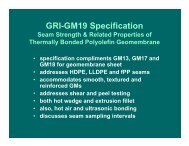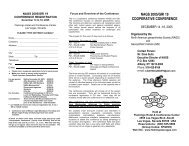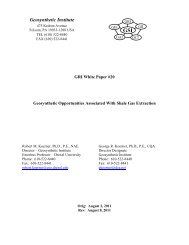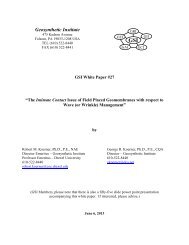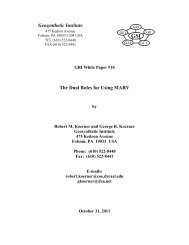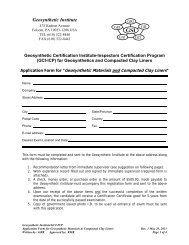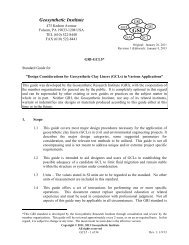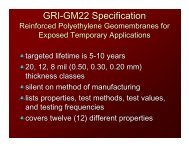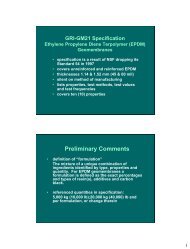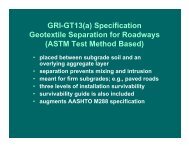GM14 - GM Sampling by Attributes - The Geosynthetic Institute
GM14 - GM Sampling by Attributes - The Geosynthetic Institute
GM14 - GM Sampling by Attributes - The Geosynthetic Institute
Create successful ePaper yourself
Turn your PDF publications into a flip-book with our unique Google optimized e-Paper software.
<strong>GM</strong> 14 - Appendix A - <strong>The</strong> Selection of the "I" and "D" ValuesIn this appendix, the procedure used for selecting the "I" and "D" values listed in Table 2 ispresented. <strong>The</strong> required background, e.g., the concept of sampling risk and the operatingcharacteristics (OC) curves, are briefly discussed.<strong>Sampling</strong> Risk<strong>Sampling</strong> involves a degree of risk that the actual samples do not adequately reflect theconditions of the lot. For example, when using the sampling plan recommended in this guide,there are two common risks [see Juran and Gryna (1980) and Juran el. al (1974) for details]:1. A good seaming practice might be penalized. This is generally referred as the installer’srisk and denoted as the risk.2. A poor seaming practice might go undetected. This is generally referred as anowner/regulators risk and denoted as the risk.<strong>The</strong> effects (impacts) of the relative degree of these two risks are summarized in Table B1.RelativeTable B1 - <strong>The</strong> Effects of the Relative Degree of and Risks.Types of RisksDegree Installers () Risk Owner/Regulators () RiskLowHighLoose CQA control; low testingcostTight CQA control; high testingcostTight CQA control; high testing costLoose CQA control; low testing costOperating Characteristics (OC) CurvesBoth of the risks can be quantified <strong>by</strong> sampling-plan-specific operating characteristics (OC)curves. <strong>The</strong> OC curve for a sampling plan is a graph which plots the probability that thesampling plan will accept a lot (i.e., the Pa value) versus the percent defective samples in thatparticular lot. Note that the term "sampling plan" used here corresponds to a batch of "n"destructive testing samples and the criteria for adjusting the sampling interval. Recall Table 2 inthe main body of this guide. Figure B1 illustrates the concept of OC curves. In Figure B1, thedashed curve represents an "ideal" OC curve. Here it is desired to accept all lots having less orequal than 2% and reject all lots having greater than 2% failures. In reality, all sampling planshave risks that a "good" lot will be rejected or a "bad" lot will be accepted. This is illustrated <strong>by</strong>the solid S-shaped curve shown in Figure B1. It is seen that this particular sampling plan willhave a 5% risk (100% - 95%) of rejecting a lot having only 1% defects (i.e., a "good" lot) and a10% risk of accepting a lot having 5% defects (i.e., a "bad" lot).<strong><strong>GM</strong>14</strong> - 10 of 12 Rev. 1: 1/9/13



